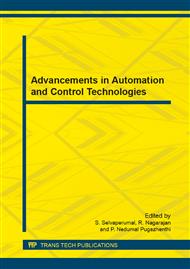[1]
Rauf Tahamiler, MD; Murat Yener, MD; SalihCanakcioglu, MD., Detection of the Nasal Cycle in Daily Activity by Remote Evaluation of NasalSound, Arch Otolaryngol Head Neck Surg. 2009; 135(2): 137-142.
DOI: 10.1001/archoto.2008.537
Google Scholar
[2]
Zhi Li Huang, Kee Leong Ong, Sze Yi Goh, Han Lim Liew, Kian HianYeoh, Facs, Frcs (Edin), And De Yun Wang., Assessment of nasal cycle by acoustic rhinometry and Rhinomanometry, the American Academy of Otolaryngology– Head and Neck Surgery Foundation, Inc. 0194-5998/(2003).
DOI: 10.1016/s0194-59980300123-2
Google Scholar
[3]
R. Eccles., A role for the nasal cycle in respiratory defence, European Respiratory Journal ISSN 0903 – 1936., ERS Journals Ltd (1996).
DOI: 10.1183/09031936.96.09020371
Google Scholar
[4]
AtanasTodorovAtanasov, Pavel DonchevDimov., Nasal and sleep cycle – possible synchronization during night sleep, Medical Hypotheses 61(2), 275–277 (2003).
DOI: 10.1016/s0306-9877(03)00169-5
Google Scholar
[5]
James N. Baraniuk, MD, and Dennis Kim, MD., Nasonasal Reflexes, the Nasal Cycle, and Sneeze, Current Allergy and Asthma Reports 2007, 7: 105–111.
DOI: 10.1007/s11882-007-0007-1
Google Scholar
[6]
SenolDane, NeseBalci., Handedness, eyedness and nasal cycle in children with autism, Int. J. Devl Neuroscience 25., 223–226 (2007).
DOI: 10.1016/j.ijdevneu.2007.03.005
Google Scholar
[7]
PiotrBoguski, AntoniGrzanka., Nasal cycle analysis with the use of acoustic rhinometry, IEEE International Workshop on Medical Measurements and Applications Canada - May 9-10, (2008).
DOI: 10.1109/memea.2008.4542998
Google Scholar
[8]
Kerstin Wiesmiller, Tilman Keck, Richard Leiacker, JorgLindemann., Simultaneous in vivo measurements of intranasal air and mucosal temperature, Eur Arch Otorhinolaryngol264: 615–619 DOI 10. 1007/s00405-006-0232-6123., (2007).
DOI: 10.1007/s00405-006-0232-6
Google Scholar
[9]
TsakiropoulouEvangelia, MD Leiacker Richard Rettinger Gerhard, MD, PhD LindemannJoerg, MD, PhD KonstantakosVasileios., Temperature and Humidity Measurements in Nasal Cavity, International Workshop on Medical Measurements and Applications Cetraro, Italy May 29-30, (2009).
DOI: 10.1109/memea.2009.5167957
Google Scholar
[10]
SatagopamMitti Mohan, SagiliChandrasekhara Reddy & Lee Yoong Wei., Modulation of intraocular pressure by unilateral and forced unilateral nostril breathing in young healthy human subjects, International Ophthalmology 24: 305–311, (2001).
DOI: 10.1023/b:inte.0000006764.65209.06
Google Scholar
[11]
K. J. A. O. Ingels, F. Meeuwsen, H. L. C. J. van Strien, K. Graamans, and E. H. Huizing., Ciliary beat frequency and the nasal cycle, Eur Arch Otorhinolaryngol (1990) 248 : 123-126.
DOI: 10.1007/bf00240235
Google Scholar
[12]
M. L. SHARMA., Evaluation of Nasal Resistance to Air Flow, Indian Journal of Otolaryngology, Volume 31, No. 3, September, (1979).
Google Scholar
[13]
V. M. D. Struben M. H. Wieringa C. J. Mantingh J. C. de Jongste L. Feenstra., Nasal NO measurement by direct sampling from the nose during breathhold: aspiration flow, nasal resistance and reproducibility, Eur Arch Otorhinolaryngol(2006).
DOI: 10.1007/s00405-006-0059-1
Google Scholar
[14]
Thomas Kjaergaard, MD; MiladaCvancarova, MSc; Sverre K. Steinsvag, MD, PhD., Relation of Nasal Air Flow to Nasal Cavity Dimensions, Arch Otolaryngol Head NeckSurg/Vol 135 (No. 6), June (2009).
DOI: 10.1001/archoto.2009.50
Google Scholar
[15]
Soren Berg, James S. J. Haight, Victor Yap, Victor HoffsteinAnd Philip Cole., Comparison Of Direct And Indirect Measurements Of Respiratory Airflow: Implications For Hypopneas, American Sleep Disorders Association And Sleep Research Society (1997).
DOI: 10.1093/sleep/20.1.60
Google Scholar


